Today’s review is for a 1985 Guild S284 Aviator with EMG pickups. I bought this from Guitar Center’s used website that contained a single terrible picture in the hopes that it would pay off like some of my other Guild purchases have.
The S284 is from the higher end of the Guild New Aviation line from the 1980s and came with a list price much higher than some of the other guitars such as the S270 or S281 Flyer. Is it worth the increased price? Let’s find out.
Introduction
Made for only about four years, the Guild S284 Aviator is one of the higher-end models in Guid’s New Aviation line from the 1980s. Early models came with a poplar body, and rosewood fretboards, but the design seems to have changed over time to include an ebony fretboard as standard feature as can be seen in the two price guide snippets shown in this section.
The body of the Guild S284 Aviator is pretty unique, and I think the best way to describe it is that the lower half of the body resembles a Strat including the nice bevel on the top, while the upper half resembles a double-cut Tele, and believe it or not, Fender did indeed make a double-cut Tele as a special edition in 2015.
It’s tempting to say that the upper half looks like a Les Paul Jr, but that guitar has a much skinnier waist than the Tele or Strat. The reason I think it’s a combination of both a Strat and a Tele body is the fact that the Strat’s body is longer than the Tele and the waist is a bit higher (closer to the neck) on a Strat than it is on a tele, but the Tele’s horns are more rounded which is what I see on the S284. Then again maybe I think that because I’ve never seen a symmetrical double-cut Strat before.
The Guild S284 Aviator can be found with a pretty wide range of configurations which can make then difficult to identify. You may find two that look almost completely different from each other while still remaining S284s. Take this maple-bodied two humbucker version found in this thread over on Let’s Talk Guild (LTG). It’s a stunning guitar, but if you were to put it side by side with the guitar that is the subject of this review you’d probably think they were different models when, in fact, they are both S284s. Remember, early models had a rosewood fretboard while the maple body was a $100 upgrade as were the EMG pickups which could be ordered in a variety of configurations. You may also find S284s with the same configuration as mine but without a pick guard since Guild changed this as part of the standard configuration as well.
The much rarer S285 has binding on the neck and headstock, but I’ve not managed to ever see one of these in person or even online. If you’ve got one please do leave a comment because I’d love to see it!
To recap, you may see some with a pick guard and some without, and the ones without pick guards seem to have “Avitator” on the headstock while mine does not, though I can’t make the blanket statement that these things changed at the same time. Seeing as how so many differences are seen and how Guild stopped using truss rod covers with engraved model numbers on many of the ’80s models (reportedly due to the change in the headstock design from more traditional Guilds), how can you tell if you have an S284 in your hands vs. say, an S270, S280, or S281?
The key seems to be the body shape. The Guild S270 has a Strat-like shape while the S280 and S281 has sort of a melted Strat body shape. The S270, S280, and S281 all have asymmetrical horns meaning that the top horn is longer than the bottom horn just like on a Strat. The S284 and S285 both have symmetrical horns meaning that they’re both the same length. The S284 has the angular “pointy” headstock (as does the S281) while the S270 and S280s have the rounded “foot” headstock.
Thanks to Kurt over at
The Guilds of Grot for his scans of these fantastic Guild marketing handouts. Some of these, like the New Guitarchitecture handout, are all but impossible to find these days so his willingness to share and make these images available makes articles like this one possible.
Another big differentiator of the S284 and S285 is the fact that these guitars had glued-in set necks while the other models listed here all have bolt-on necks.
The Guild S284 was good enough to be listed on the cover of the New Guitarchitecture catalog/flyer from the mid 1980s which shows a delightful hot pink model along with the wild X100 Bladerunner. Note that the headstock has the same matching color while in the price guide for a later year the headstock is black regardless of the body color which is yet another variation you may find.
Remember that this was the 1980s so bold colors, wacky graphics, and sharp angles were the order of the day, all of which are in abundance in this bit of vintage Guild marketing gold.
Note that both of the Guild S284s shown on these catalog pages have the rosewood fretboard and have pick-guards while the hot pink one on the cover has EMG pickups which were an option that was likely chosen by a fair number of buyers since, you know, it was the ’80s. The Ted Beesly book shows an example with a single humbucker and a stop tailpiece that he refers to as a 1985 Aviator basic model, though I’ve not seen one of these in the wild.
Again, looking at both of those pictures, the thing to notice that makes them S284s is that that they both have symettrical horns on the body. Well, that and the fact that the catalog explicitly states what models they are, but seeing as how there are a fair number of questions online about how to identify an S284, I figured I’d point that out one more time.
Originally I found no artist endorsements for these gutiars, but thanks to the tireless team of research analysts over at Lets Talk Guild, I discovered that Joe Perry and Steve Vai both had S284s with Joe Perry’s shown in the December 1987 issue of Guitar World magazine.
Steve Vai’s references were sadly due to a couple of S284s being stolen which is mentioned in the January 1987 issue of Guitar World magazine with an additional follow up to the article in the book, The Complete History of Guitar World where it mentions that the S284 that was stolen was a pink and black tiger-striped Guild S284 Avatar [sic] with a Floyd Rose, two EMG humbuckers and an EMG single coil in the middle along with a left-handed headstock. Man, would I ever love to see that guitar.
I also discovered that Bobby Messano, former guitarist with Steve Winwood, had scored an endorsement deal with Guild as shown in this ad from the mid-80s. Both of those are killer-looking S284s, and I have to wonder what the deal is with the pick-guard on the black one. Is it some sort of special pearloid red? Is it reflective and showing something in the mirror finish? Either way they’re both sexy as hell and I want them. If you own one that looks like either of those please contact me so that I can throw money at you. Wait, I own a black one already, so only red or other boldly colored S284s are eligible for the cash-tossing offer. And S285s. And X100s. And all the Guilds. I want all the Guilds.
I do not have a Guild problem; I can stop any time I want to.
Take a look at that red S284 in the Bobby Messano ad. See how it has a pick guard? Well, they didn’t all look like that. This picture is from a different marketing handout that shows a later model S284 with no pickguard, the ebony fretboard, and the headstock that says Aviator after the Guild logo.
I don’t know how many Guild S284s were made, but after researching them for a couple of days I’m starting to think that damn near every single one of them is different. It’s no wonder people have trouble identifying them. I dig ’em all, though I’m always partial to ebony fret boards.
Finally, check out this picture of a young Brian Setzer playing a Guild Bluesbird circa 1986. What’s that I spy in the background but a Guild S284 Aviator, not to mention a killer Guild acoustic.
The guitar that is the subject of this review is a 1985 model with an ebony fretboard, pick guard, Kahler, and EMG pickups, though I do also have a blue version that’s almost identical save for the fretboard which is rosewood. I will show this guitar as well when needed or when I feel like it. I’m crazy that way.
Finish
The black Aviator in my possession has pretty clearly been refinished. After the discovery of this thread (thanks, Hans!) which talks about this very guitar, it quickly became clear to me that this guitar is not in original condition. It is therefore unfair to judge Guild or the guitar on the finish. But the tale is not quite as simple as I’d first thought. According to Hans, with the refin of such high quality and the fact that the headstock face is black and the original logo is visible, it’s possible the Guild actually did the refinishing of this guitar which may explain why it’s so well done.
The normal finish has got to be poly based on the chips and dings I see on these guitars. You can see an example of this if you zoom into the blue S284 to the right and look at the strap peg where there is a large chip.
I will say that whoever refinished the black S284 guitar did an excellent job because if it wasn’t for my critical eye I may not have ever known. A few key things jumped out at me, though, not the least of which is the fact that there seems to be significant buckle rash (buckle gouging, really) underneath the finish.
The next sign that something was up were the wear marks. These pointy ’80s shred-machines almost always have significant wear on the pointy bits and this guitar is no exception. The problem is that the finish wear shows what appears to be either pink or red underneath the nice black. Or does it? If you zoom into that picture of the headstock point, the color that seems to show through is blood red, and the person in that link from LTG talks about how the guitar had a blood spatter motif. Further, looking at the picture of the point there are clear indications of the blood read color on top of the black paint which makes me think that someone filled in the chip with something very red.
Another reason that both the refin and the paint scheme may both be present is the fact that the holes left by changing the tuners and the wear under the Made in USA stamp on the back of the headstock are very clearly pink and not blood red. Interestingly, these are the tuners used on another LTG member’s Aviator as seen in this thread. I really like Grover tuners but I really dislike visible holes, so this picture fills me with a fair bit of obsessive angst.
I could not find a list of what colors were available, but given the wide variety of examples I’ve seen in the wild, my guess is that the colors available were all of them. I am a fan of the bright primary color models including the blue one shown here. I think the bold color offsets the black pick guard very nicely making a beautiful eye-catching contrast that you don’t get on the all-black model.
Fretboard and Neck
The black S284 has a beautiful ebony fretboard with a scale length of 25 5/8″. The neck is unbound on the S284 and if you find one with a bound neck then you’ve got yourself a relatively rare S285 that I’d love to see and/or buy.
The neck is perfectly straight on this guitar and reminds me of my beloved S300s. The neck is 1 5/8″ at the nut and the frets are .100″ wide by .035″ high but given the fact that the frets are perfectly crowned on this otherwise refinished and seemingly well-used guitar, I have a feeling that these frets were resurfaced and may have been taller when new.
The blue S284 has a rosewood fretboard with similar measurements, and if you look closely at the pic to the right, you’ll notice a broken section right through the low E tuner. Breaks of the pointy bits are fairly common with these pointy guitars, and luckily this one was repairable, even if it isn’t the prettiest repair ever.
I believe Guild may have hand-sanded these necks so it is possible to find variations between two guitars of the same model, though in my experience Guilds tend to be remarkably consistent.
For the depth measurements I measure just before the fret listed, measuring from the top of the fretboard’s radius crown to the bottom of the neck’s carve. The neck shape is an approximation based on feel.
This guitar has a slight neck angle of maybe 1 degree, probably to accommodate the Kahler bridge. There is no binding on this neck (again, it would be a rare S285 if the neck and headstock were bound) and the inlays are simple dots.
The headstock is what Ted Beesly calls the Pointy Droopy design, but I see most people call it offset on the forums. Regardless of what it’s called, these headstocks almost always have finish chipping at the tip because those tips are constantly banged into things and the finish just can’t take the stress.
The Kahler locking nuts used on the Kahler-equipped Guilds are not my favorite piece of hardware. I have no problem with them in use, but when restringing the guitar I find that getting the B and high E string routed through the nut to be a huge pain in the ass. Note that this is technically not a locking nut, but more accurately a string clamp that sits behind the nut which is the standard for Kahler-equipped guitars since the ’80s.
Build Quality
These are well-made guitars but because they have pointy bits, those pointy bits usually have finish missing, if not absent chunks of wood.
The neck joint on every Guild set-neck guitar I’ve owned has been superb, and these guitars follow that trend. The weight pf the black Aviator pictured is 7 pounds 15.9 ounces, or to everyone else who doesn’t feel the need to be so precise, 8 pounds.
The body shape is a little weird for me because I expect the longer upper horn of a Strat type guitar, so the equal horns actually look reversed to me at times – almost as if the lower horn was slightly longer. It’s an illusion based on years of expectations planted in my mind by Fender, but it’s a strong one, at least to me.
Pickups
According to this page, EMGs with gold logos have Alnico magnets while EMGs with silver logos have ceramic magnets. The humbucker is quite obviously an EMG 81 given the huge label on the back espousing that fact while the single coil pickups appear to be SA models given the gold logos.
One of the frustrations of dealing with older EMG pickups is that many of them are not marked at all. The EMG 81 clearly is, but the two single coils are not, though as stated above, they seem to be SAs based on the gold logo. That’s great so long as the logos isn’t worn off which is a common problem on well-played guitars. The wiring is fairly typical for an EMG HSS (humbucker-singlecoil-singlecoil) configuration and will be covered in detail in the next section.
This guitar appears to have been designed from the get-go to support active pickups given the nice battery compartment, though the battery compartment would have been even nicer if it had a quick-release cover. Instead, you still have to unscrew (and potentially lose) four pick guard screws to get to the battery. Hey, at least it’s not slamming around in the control cavity.
You may notice in the pics of the Black S284 that the bridge pickup has a bit of an angle to it. I’ve straightened it out since taking these pictures.
Electronics
First off, can we all agree that, Holy excavation route! Sure, some Strats get the complaint of having a swimming pool route, but this thing looks like a swimming pool along with a wading pool and an attached jacuzzi. Add some copper foil to make it look like a swimming pool on a NASA satellite and it all adds up to I was happier before I took the pick guard off. Damn.
Yeah, the pickup route is gargantuan, but at least there didn’t also need to be a route in the bottom for Floyd Rose springs! After reviewing and working on many ’80s Guilds it’s become obvious why Guild used Kahlers: they work better on thin flat guitars.
The wiring is pretty standard for an EMG HSS layout with two 25K pots, a .1 μF capacitor, and the appropriate wiring to the standard 5-way blade switch.
The wiring is actually a bit neater than I’d expect looking inside an ’80s guitar, but remember that the black Aviator was reborn after someone lovingly restored it, so the nice wiring may be a result of that persons dedication.
All three pickups are grounded by ganging the shields from all three signal wires together and soldering to a pot. Similarly, all three pickups get 9V from the battery by ganging the wires together when connecting to the battery lead.
As with most active pickup guitars I’ve seen, the output jack is stereo to allow the ground to be broken when the cable is unplugged which allows the battery to last much longer.
Hardware
The tuners are quite clearly replacements on the black Aviator given the visible holes left in the headstock, but the new tuners are probably better than the stock Guild inline tuners used during this era. The pic of the blue S284 headstock in this section shows the typical Guild tuners for this guitar, though given the variety of configurations out there it wouldn’t surprise me to see either on a stock Guild.
The knobs are knurled metal affairs like most of the pointy ’80s Guilds, though I would also be fine seeing slotted speed knobs on a guitar from this era.
The strap pegs are a little wider than vintage, and I have no idea if they’re original. Both of the S284s in my possession have the same pieces on it, so it’s possible that they are original.
These guitars have Strat-style output jacks that are on the pick guard which is relatively unique (can something be relatively unique?) in the Guild world as most of their electrics have the output jack on the side or the top using regular jacks and not the angle Strat-like example.
The bridge is a Kahler 2300 Pro on both of these S284s and I have to say that having owned and reviewed a fair number of Kahler-equipped Guilds, this bridge is growing on me. My only complaints with it have to do with it going out of tune more easily than a Floyd Rose and that may have something to do with the fact that it’s pretty easy to hit the fine tuning knobs when palm muting if you’ve got big hands. I love the simplicity of the design and especially love the lack of an additional route for springs on the bottom of the guitar. Good thing, too. I mean, did you see that route under the pick guard? The last thing these guitars need is more routing.
The pick Guard is not original on the black guitar but is fantastically well done and I’d never have known if not for the original thread on LTG and the fact that there is a sticker from Chandler on the underside.
I had to look them up, but I must say that based on the perfection of this guard, I’ll definitely check them out should I need any other replacement pick guards.
Sound
The guitar delivers decent strat-like tones from the EMG single coils and the EMG 81 delivers that “clinical” distortion that sounds so cool with the right amp. EMGs are great for high gain and this guitar delivers in that realm quite nicely. It’s tempting for me to say that this is just another pointy guitar with EMG pickups, though, and as unpopular a thought as that may be to Guild purists, hear (read) me out.
In my opinion, having owned over 100 guitars (yikes!) a solidbody guitar with EMGs sounds like a solidbody guitar with EMGs. I may get some heat for that statement, and I’ll agree that there are nuances where wood, body thickness, and even fretboard material play a part, but for me I can dial almost all of those subtleties in or away with EQ and a nice amp, especially in the realm of high gain. For me, the differences in all those things having to do with wood and build determine the playability of the guitar which, in an EMG-equipped instrument, is far more important to this old rocker.
Don’t get me wrong – I really like these guitars, but it’s not because of the pickups.
The recordings were done on my Axe-FX Ultra setup through the QSC K12 speaker recorded into my trusty Olympus LS-10. As usual, I recorded using the Tiny Tweed patch, as well as the JCM-800 and one through a setting called Backline which is the “I wish it was still the ’80s” setting I like so much.
For each recording I cycle through the all of the 5-way switch settings from Neck, Neck + Middle, Middle, Middle + Bridge, and finally Bridge. All knobs on the guitar are on 10 at all times.
Note that if you’ve been reading my reviews as they’ve been released that these recording were made on my Axe-FX Ultra and not my newer Axe-FX II XL+, and that’s because the majority of this review was written months ago. Hey, I’ve got a job, you know.
Playability
Let’s get to the point. How’s it play?
This is a fabulous guitar whether played seated, standing, or anything in between. It actually reminds me of my coveted Guild S300s a lot and there’s obviously something about the feel of the guitar that makes me think that, which is probably the similar set-neck geometry. It’s a very different guitar, though, and not just because of the shape. The pick guard, the single coil pickups, and the Kahler all add up to this guitar being its own thing, and of course the shape is kind of unique (kind of unique? I think I need a dictionary), too.
The neck is smaller than I prefer at 1 5/8″, but with the ebony fretboard it just feels so nice. The Blue one with its rosewood board didn’t feel quite as refined to me, but that’s being a bit nit-picky on a quality US-made guitar that I bought for less than $500.
With its long scale, Strat-like body ergonomics and Kahler, this is about as super as a Strat can get, even if it doesn’t really look like a Strat.
Conclusion
I really enjoyed these guitars, and especially liked the one with the ebony fretboard, though if I’m honest I’m kind of tired of black guitars and wish that the blue one had that feature. Such is the life of a vintage guitar hunter.
It’s not really fair to judge the entire series based on this one guitar, which is why I nabbed the blue one to see if there were any great differences. To my surprise, I liked the black one better which again comes down mostly to the fretboard.
Where these guitars shine is the fact that they are a LOT of guitar for the money. I could easily sell the parts on the blue one for more money then I spent on the entire guitar, but since I detest people that do that, I’ll either sell it or keep it as a beater shred machine. As much as I like them, though, if you’re looking for an archtypal super-strat I’d have to point you to a Charvel or Jackson which are on a whole different level. The problem is that one of those will set you back anywhere from two to ten times the price I paid for either of these gems.
Would I recommend one of these guitars? Absolutely, especially if you find one for the right price, and the thing about these guitars is that they mostly fly under the radar as ’80s pointy guitars that no one has ever heard of do the chance of finding one for the right price is high. Thats is, if you can find one at all.
If you see one of these old Guilds in a pawn shop, go pick it up. You might just fall in love with that pointy old ’80s monster. Besides, it’s not really that pointy. I can almost guarantee that it will play like a dream for a great price, though, and what’s not to love about that?
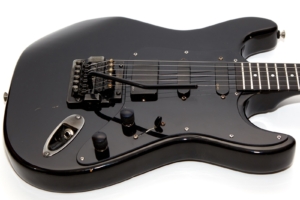
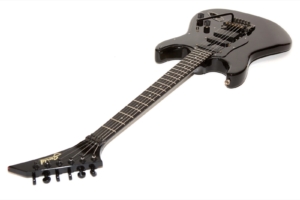

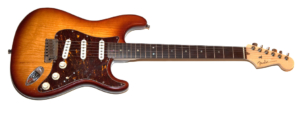

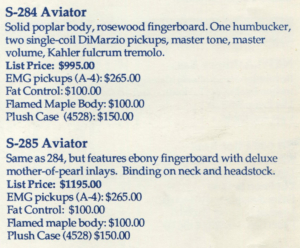
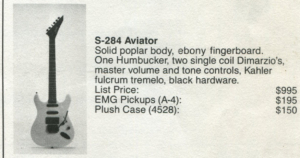
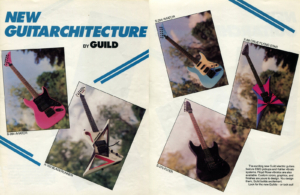
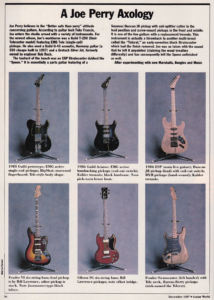
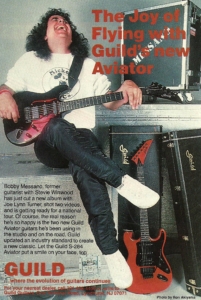
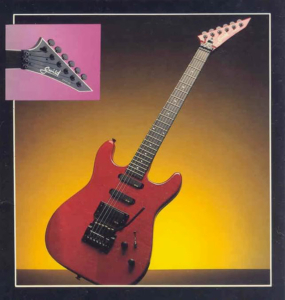
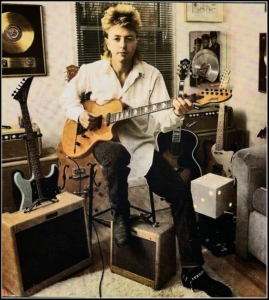
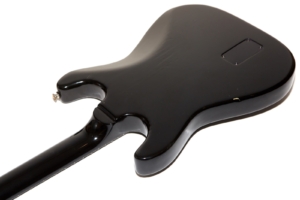
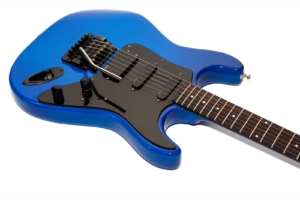
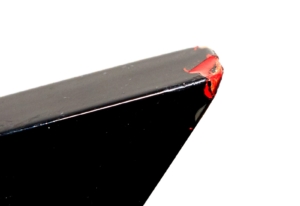
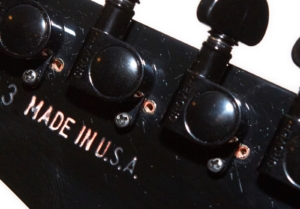
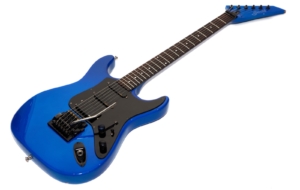
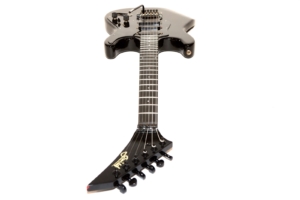
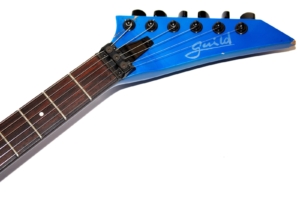
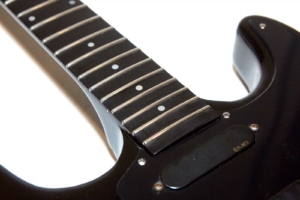
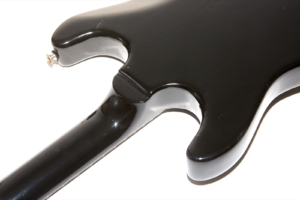
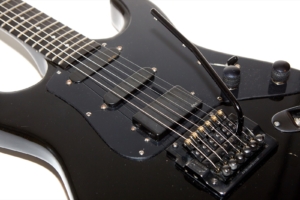
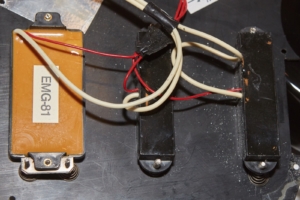
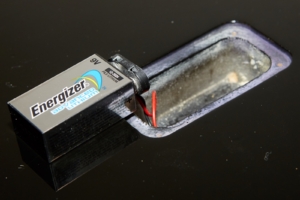
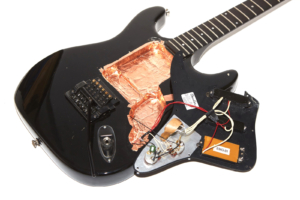
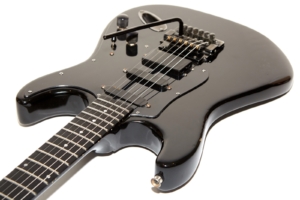
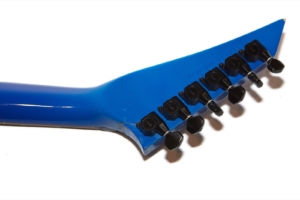
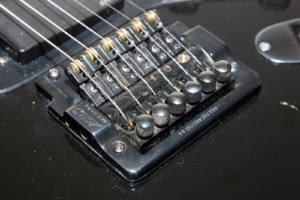
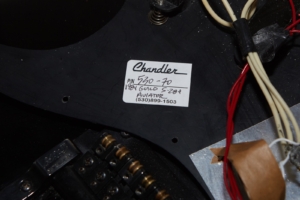
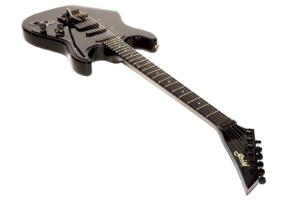
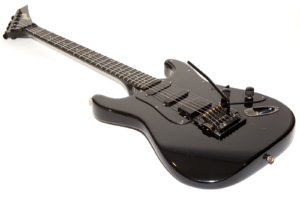
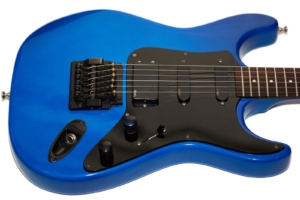


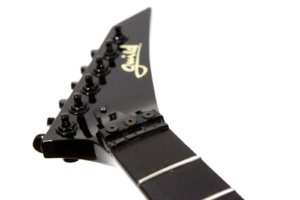
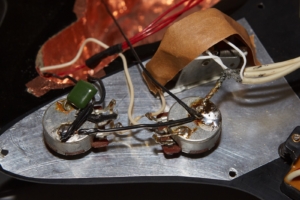
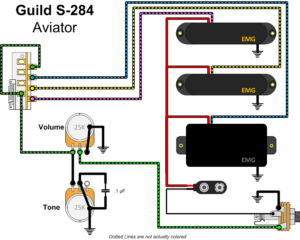




I have owned & played a super hot pink one of these since the late 80’s. It may be my preference or just I lucked and got one built when the stars were aligned correctly, but I will have to say this. It is probably the best playing guitar I have ever laid hands to. Everyone that sees it cracks a joke about the color, plays it then tries to buy it. Wish I had a room full of them.
I have a red S-285. #2 of the very short production line of 11 total according to the serial number chart so it is not a surprise you have not seen one. I bought it on ebay a couple years ago. I gave it to my son who likes it very much (and will never part with it). Has the white binding and the rising (or is it setting?) sun inlay they had on the Liberator Elites. Kahler Fulcrum trem. SSH EMG pickup config with a push pull tone knob to switch the humbucker to a single. It’s a neat guitar. I have never seen any others. Has a few dings and discoloration due to someone putting stickers on it years ago which is a shame because there are so few specimens of this model.
I would love to see it! Could you send me some pictures to gad @ gad . net?
Hi,I have a Guild Aviator in black that turns out was Joe Perry’s a bit of a long story short It has a Asset tag that say property of Aerosmith,took a bit of research and a tweet on Twitter at the time to Billy Perry and she put me in touch with John Bionelli and he confirmed via emails that it used to belong to Joe Perry and was used on the personal vacation tour but not used much after that.
This is the most information i have found on Guild Aviator’s great article thank you.
What a great story – thanks for sharing!
I didn’t quite get it from the sound samples, but does the Guild Aviator give a strat-type cluck in pickup positions 2 and 4? There is one for sale in my neck of the woods and I’m trying to determine if it would be worth while as a working guitar, or more of a nostalgia trip. Thanks.
Oh man, I so wanted an Aviator back in the 80s. Ended up with a Guild Burnside (made in Japan). After the tremolo frame broke, used the neck with my obligatory wood shop guitar.
As always, love your articles and the info you share. I started today’s read to determine the difference between a Songbird (I have a Songbird Killer… a Quilt-top Peregrine Custom Shop – see what I did there? The Peregrine is the world’s fastest hawk) and a Nightbird. I remember seeing and not being able to afford a Nightbird (all I remember is Black), and forgot it was a chambered electric, where the songbird is a hollowed hole under the soundhole semi-solid acoustic.
Do you do all your own photography (not including those pictures you associate with web-pics)? Your photos are very clean with no background clutter and no flash reflections and other distracting marks. Do you have some tips for getting those pro-shots?
[snip]
I found this article interesting because I have never found an S28? just like mine. Now I know it is NOT an S284 because mine is a bolt-on neck, with the asymmetrical horns and what I call the “fastback” that makes it hard to put in a standard stand.
After seeing Glenn’s comment, before I got my S28?, I had a red Burnside that was my goto guitar. It did almost everything I needed, unless I needed dual HB-1s in a ‘hog body or an acoustic. My baby mama, made me sell it so I could buy my F-4CE (b!tch). I lucked out and found my S28? in a pawn shop for a bit over $100 (with OHSC). I was surprised at how much more balls the imported Burnside had compared to the Guild. I recently scored a GC (couldn’t sell it) Burnside Cutlass in Black… I need to add a page for it and show it next to my S28? (but maybe I can get some of those photo tips first!)
https://sites.google.com/site/musictoworshipby/home-1/guild-s-284-
Yes i do all my own photography. Best advice I can give is to have lots of experience and gear. Each article takes over 40 hours, a fair bit of that being photography. I have a studio in my house set up for the shots I take. There is also a fair bit of post-production work that goes into the photos.
The guitar you linked to is an S281. My review of an S281: https://www.gad.net/Blog/2017/04/28/1986-guild-s281-flyer/
I have owned 3 aviators. Currently I only have one left but it happens to have an original finish of Black and pink stripes. I bought it in a pawn shop in NYC in the Kate 90s. Possibly Steve Vai old guitar? Two Emg humbuckers with Emg single coil in the middle…HSH
Thinking that I have a S284, I’ve owned it since the 80’s or 90’s, finish is rough, bunch of stickers from my punk rock days, gold writing EMG, HSS configuration.
Hello Gary,
sorry to make this question out of thin air but any chance you would know how much an Aviator (S284) goes for these days? And where’s a good place to find them?
Love your Blog btw!
R
Thanks!
Best place to find old Guilds is Reverb.com and Ebay.com. You can also troll local music stores because they do show up from time to time, but you’ll have much better luck online. As for price, it’s hard to say. They’re not really in demand, but they’re also not all that common. I’d expect a price anywhere from $500-1200 depending on condition.
Hey Gary, I’ve tried posting here about a year ago but didn’t take for some reason. I now own the Blue one. Just curious how much history you know of it? Also did the other poster ever send any pics of the s285? Would love to see them as well.
Hey there! Whatever history I had on the guitar would be in the article already. As for the S285, I do have a single picture of one that someone sent me: Guild S285
Hi Gary, my name is Ralph (formerly F312) on your forum. I’m going to the Mesquite guitar show Saturday 10/19/24. I will be selling two Aviator 284s. One white and one kind of purple.The white one has a rosewood FB and California PUs, the purple has the ebony FB and EMG PUs. If interested call [redacted] and leave a message if I don’t answer.